Back in August, it seemed like most Real Madrid fans were living for the summer of 2022.
Kylian Mbappé. Erling Haaland. Jules Koundé. Antonio Rüdiger. Paul Pogba.
Summer 2022 is when they’re all due to arrive.
At least that was the thought.
Though two or three of those players could still arrive in the next eight or nine months, Madridistas have returned to the present as Carlo Ancelotti’s side is ploughing through La Liga.
This tactical analysis will look at Ancelotti’s tactics, more specifically, investigate them relative to last season in an attempt to identify tactical and performance differentiators despite little change in personnel. I’ll have lots of data for you in each section as we break down Real Madrid’s attacking transitions and how their defensive tactics set up those direct moves to goal. To finish the analysis, we’ll take a closer look at two key influences in the squad.
Scoring goals in transition
Zinedine Zidane’s 2020/21 side managed to stay in the title race until the end of the season, but there were two clear issues with his group. Firstly, they simply couldn’t stay healthy. Real Madrid and Carlo Ancelotti have made amends here by bringing Antonio Pintus back to the club after a successful spell at AC Milan. Secondly, last season’s squad greatly struggled for goals. And not just last season’s team. This has been a recurring issue since Cristiano left Real Madrid for Juventus in 2018. In both full seasons of Zidane’s second stint at the club, finishing off quality chances, particularly from secondary goal scorers, was a major concern.
Last season, Real Madrid managed 1.66 goals per game. Still a good average, but very far from those peak BBC years.
Fast forward to the current campaign under Ancelotti and Real Madrid simply can’t stop scoring. Goals per game are up 20% from last season, and that’s without a significant rise in xG P90 (6%). To get a better grasp of all things goals and points related, I ran the data between the two seasons. In this first data visualisation, the 2020/21 season is represented by the blue circle while the current campaign is in orange.
If the categories are difficult to pick out, here is the order: 1) goals allowed P90, 2) Goals P90, 3) Points per Game, 4) xG P90, 5) xGA P90, and xPoints per game.
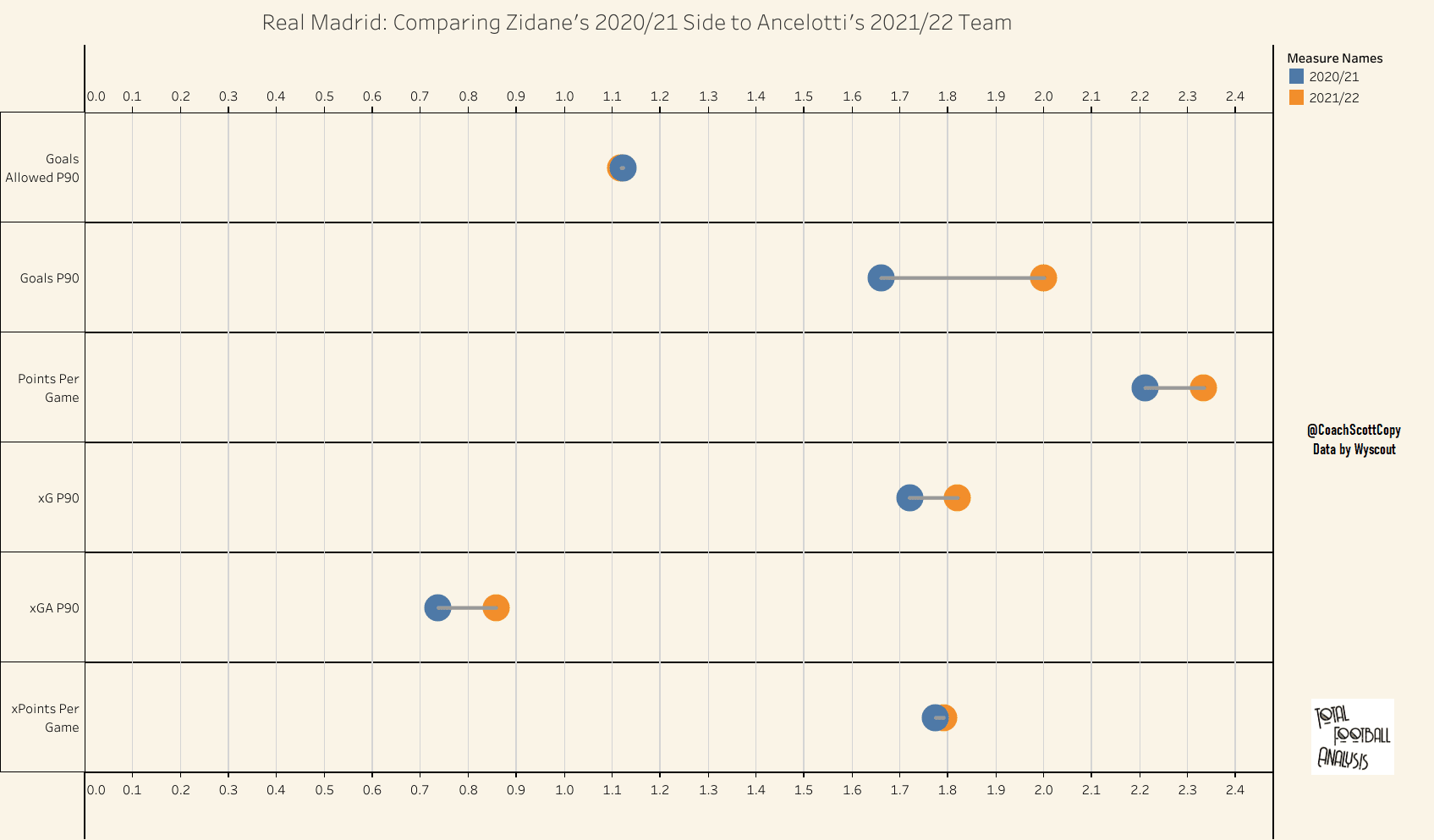
There are two significant differences. One is in goals P90 with that 20% improvement this season, though with just that 6% improvement in xG. The other category is that Zidane’s side was 16% better in goals allowed P90, but with a virtually identical xGA P90. Even xPoints per game sees Ancelotti’s side with just a 1% improvement to go with a 6% improvement in points per game. The goals for and against give us significant margins, but those numbers far exceed expectations.
That got me asking, is there any differences in attacking tactics that are borne out by data analysis?
That led me to compare the following categories, listed in order: 1v1 dribbling P90, crosses P90 key passes P90, passing rate/tempo, PPDA against, shots P90, through passes P90, and touches in the box P90.
The only category to see a downturn from last season is crosses P90, which have decreased by 19%. Thinking back to last season, Real Madrid tended to butt their heads against low block walls until they finally toppled over, or rather, if they fell. Ancelotti has taken a different route. Rather than confronting the opponent when they have 10 players behind the ball in their defensive third, his side has been more proficient in drawing the opposition higher up the pitch and creating spaces for his star players to exploit the opposition through their individual and small group qualitative superiorities.
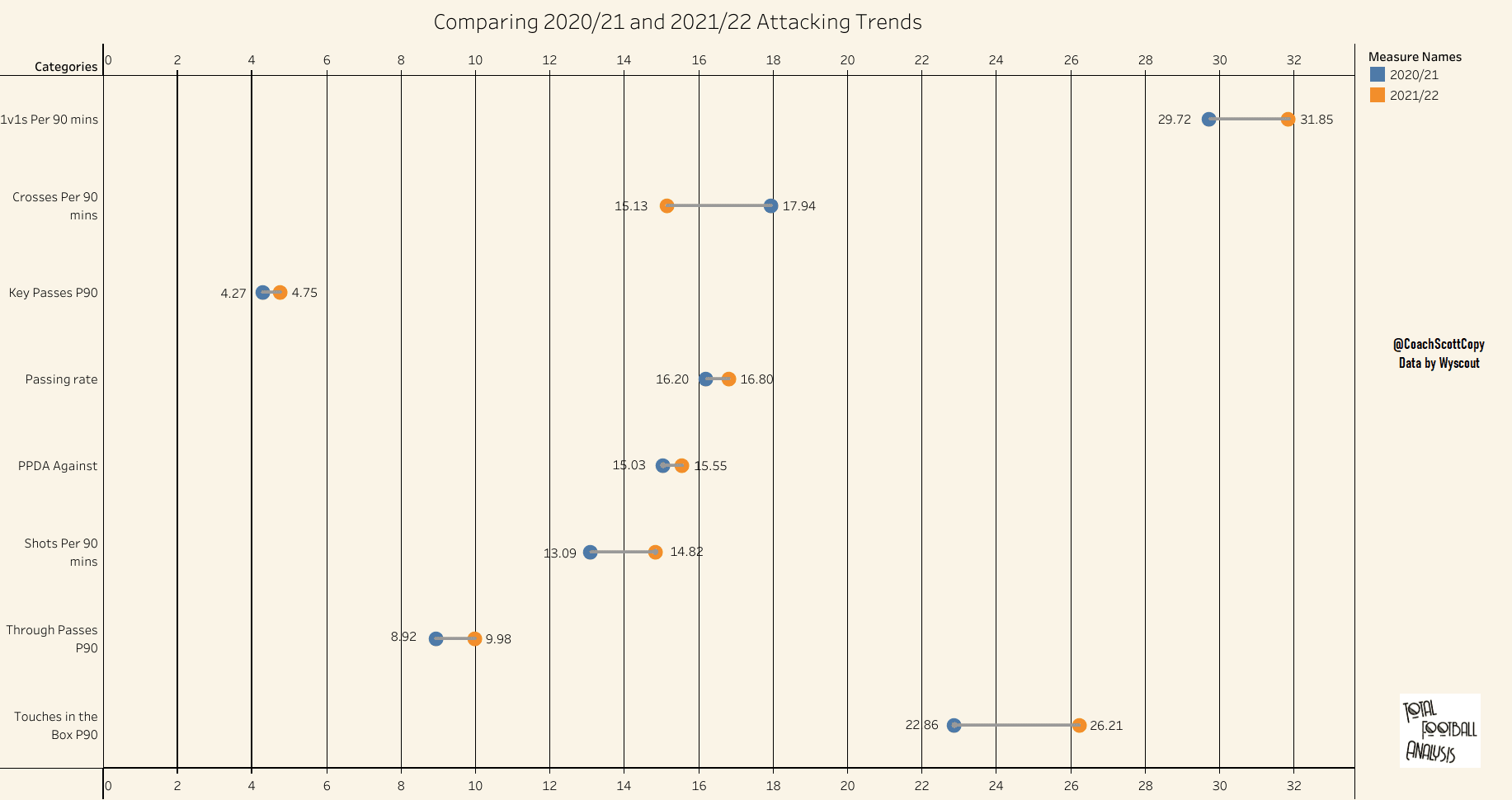
Looking at these numbers, the difference in 1v1s, passing rate and PPDA against are negligible. The major differences are in crosses, shots, touches in the box, through passes and key passes. A lesser reliance on crosses has surely played a role in the team’s attacking success. Even though xG P90 is roughly the same, the data would indicate that Real Madrid is entering the box from better positions, likely leading to better connectivity in the box and the finishing to go along with it.
That more direct approach is best characterized not just in the way this current squad attacks and transitions, but also in how they set up those opportunities.
Let’s look at our first tactical image.
Against Athletic Club, Real Madrid has just lost the ball and are bracing for the opponent’s counterattack. However, Real Madrid is well prepared with an excellent rest defence. Taking a page from Zidane’s notebook, Ancelotti has a deep central square positioned to take away access to the centre of the pitch and delay the opposition’s attack. That rest defence allows Eduardo Camavinga to aggressively apply first defender pressure and force a lateral pass, further slowing the Athletic Club counterattack.
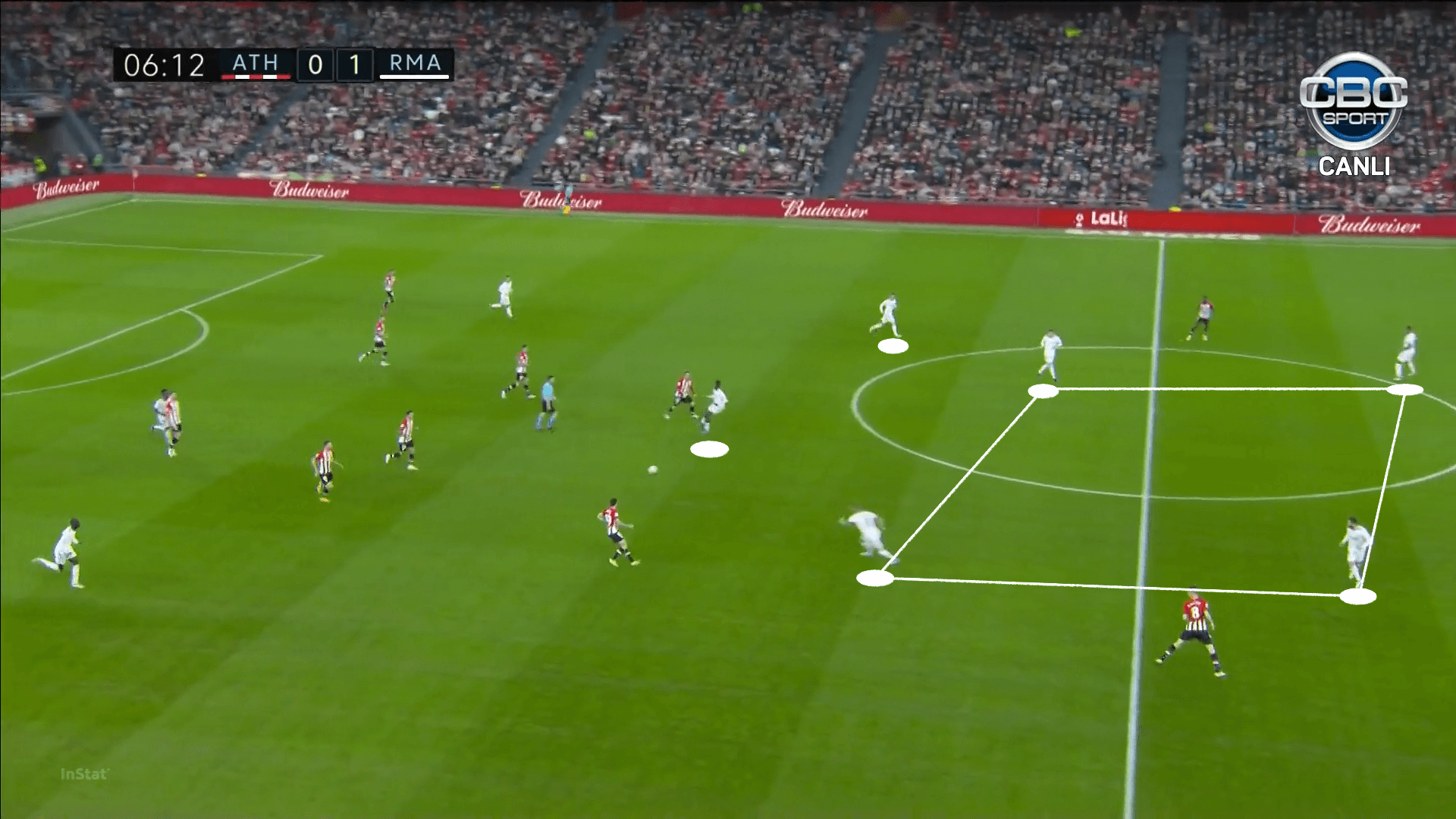
Real Madrid uses that deep central square as protection against counterattacks, which in turn buys time for the rest of the team to recover their defensive shape, especially the midfielders and outside-backs.
When playing through the middle third, you’ll notice from the second tactical image that Real Madrid does maintain a presence high up the pitch. Karim Benzema and Vinícius Jr. are the likeliest to stay in those high positions, but it’s not uncommon for Marco Asensio or Rodrygo to do the same on the right-hand side. Here, we see a recovery in the middle of their half, sparking a counterattack of their own.
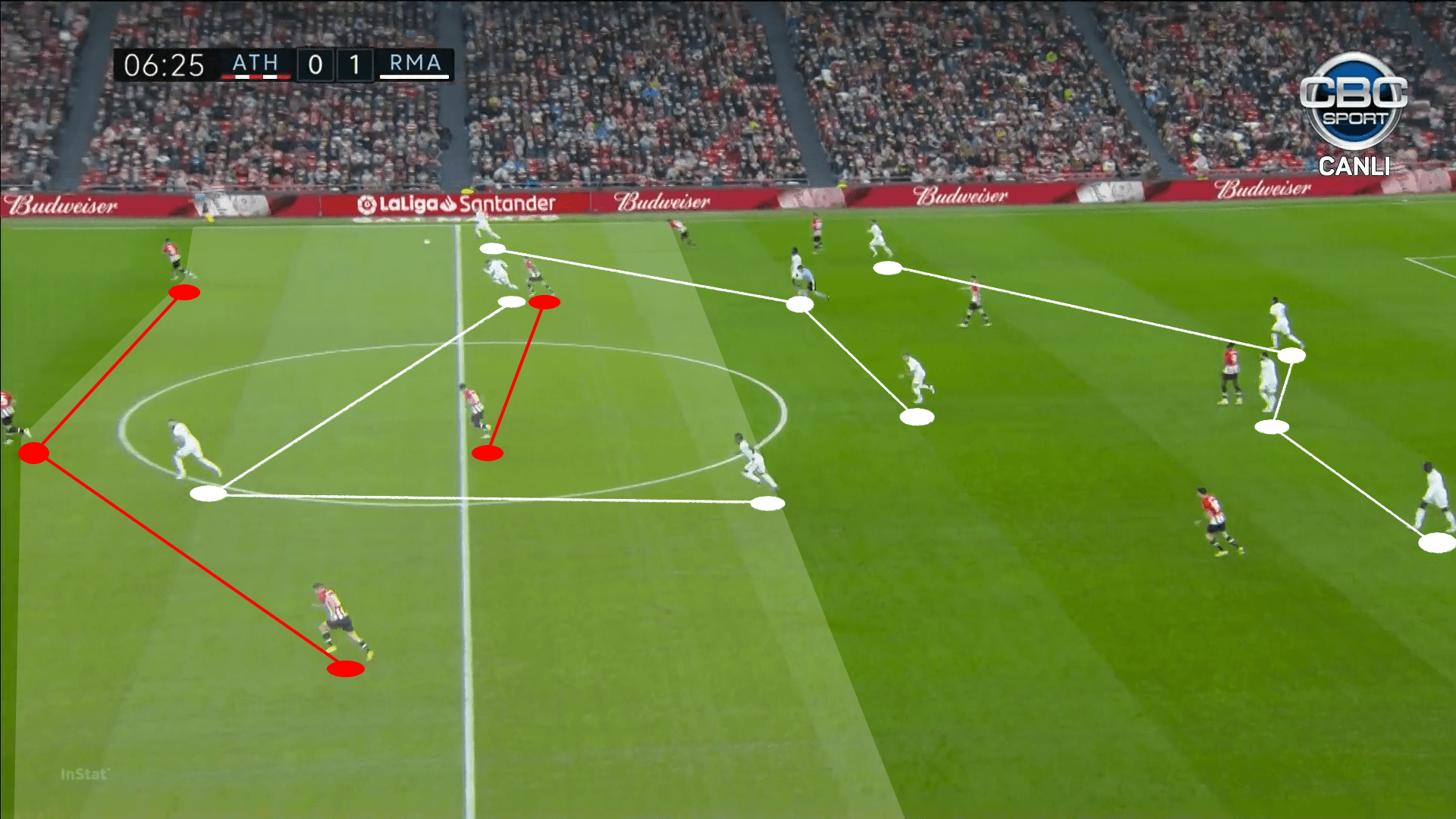
The progression in the attack is textbook. Continuing their lung-busting runs up the pitch, Real Madrid creates a 2v1 against the left-centre back, Unai Núñez, which leads to Eden Hazard in possession in the right half-space. He tries to pick out the run of Valverde, but a fortunate deflection knocks the ball into Benzema’s path, who’s wide open in the middle of the box. Big Benz calmly finishes, putting the team up 2-0.
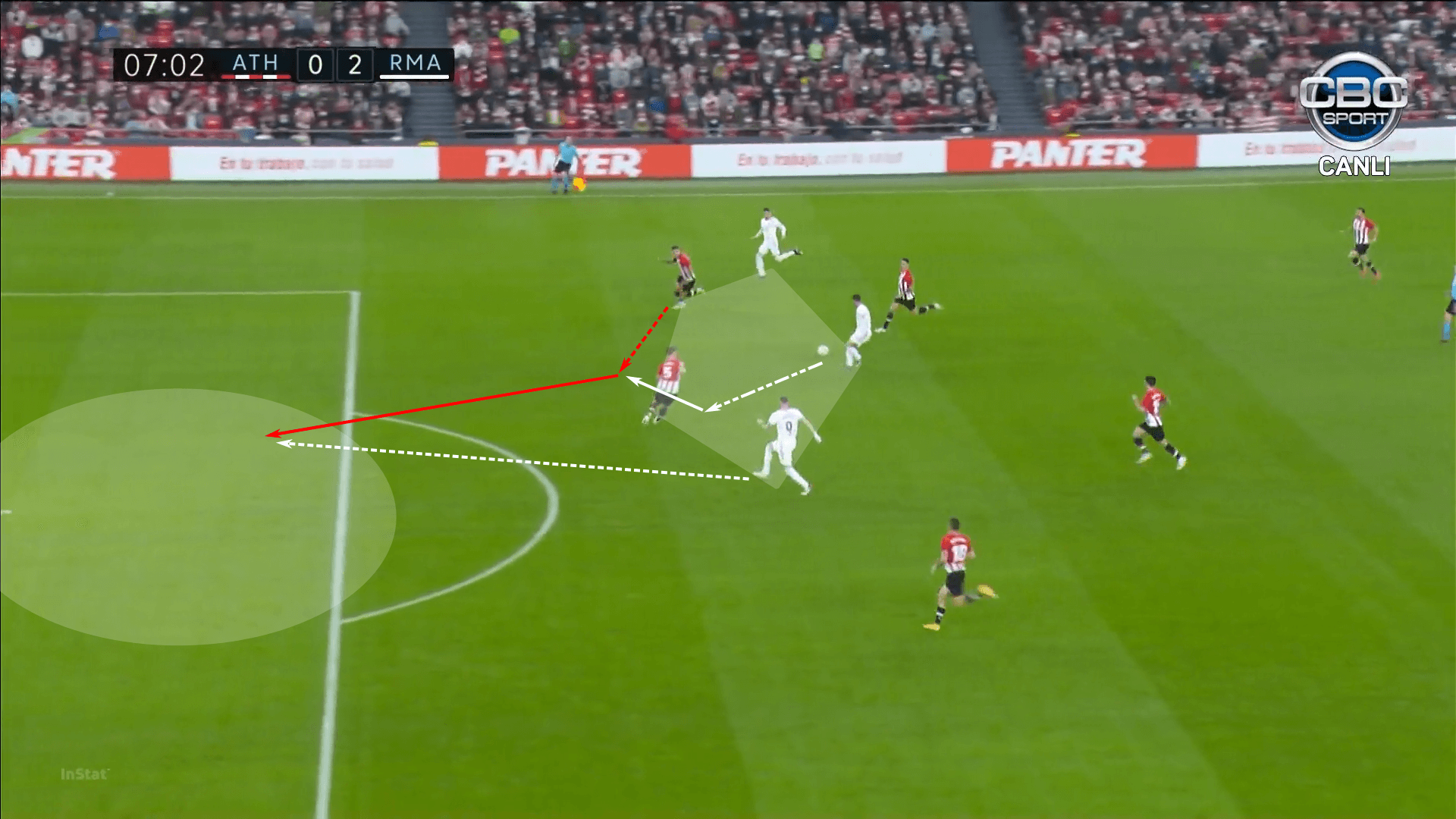
The contrast here is the line of confrontation from last season to this one. Whereas Zidane would typically position each of his field players in the middle third, initiating the press 10 to 15 yards into the opponent’s side of the pitch, Ancelotti’s defensive tactics see the current group setting a midfield line of confrontation. As the opponents reach midfield, they’re increasing the distance from each player to their own goal, elongating their recovery runs. That extra space is especially beneficial for Vinícius Júnior’s pace and Marco Asensio’s quick reaction time. With more space to attack, there’s space to manipulate as they search for direct entry into the box.
If the opponent does manage to progress deep into Real Madrid’s half, Los Blancos will move into a low block, but always while keeping one or two players high of the pitch as outlets and setting up space for the midfielders to run into. We got an example of this against Barcelona during the Super Cup.
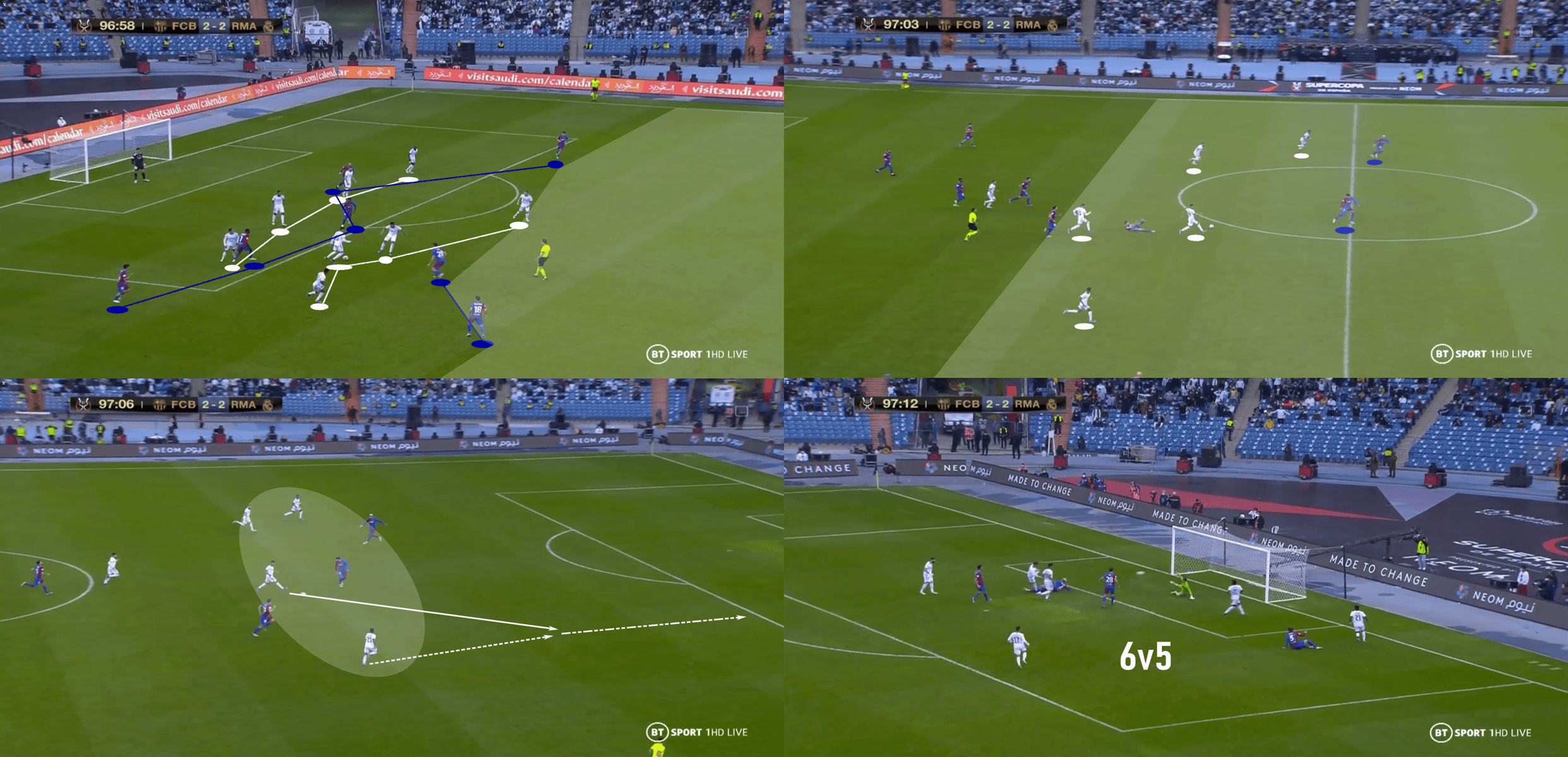
The game-winning goal started deep in Real Madrid’s end. Barcelona was in possession of the ball and pushed five players into the forward line with two midfielders in support. Horrific positional play aside, you can see in that first image, which captures the moment Real Madrid recovered the ball, that Toni Kroos is ready to burst into space.
The top right image shows Casemiro evading the desperation challenge of Sergio Busquets, giving Real Madrid a 5v2 as they enter the attacking half of the pitch. As they enter the final third, the numeric superiority decreases to a 4v3, but that third defender is still trailing the ball on the right while Real Madrid has 2v1 on the left. The bottom right image is there simply to show the result of the counterattack. As Los Blancos score the game-winning goal, they did so with a 6v5 advantage in the box.
The key points from that Barcelona example are the ease of the transition, numbers in support and numbers entering the box. That’s a recipe for success in any counterattack, which is one reason why we find Real Madrid scoring more proficiently this season.
Creating attacking transitions through defensive tactics
In the previous section, I briefly mentioned that it’s important we understand how Real Madrid sets up these counterattacking scenarios. Rest defence is a big part of it, as is sitting deeper in the pitch, but there’s much more to Ancelotti’s tactics.
Real Madrid is still a possession-dominant side despite the fact that they are so much more prolific in attacking transitions. The fact of the matter is that goals are easier to grab in attacking transitions, not just for Real Madrid but globally. There’s more space to attack and you benefit from engaging the opponent before they have an opportunity to organise.
Even though attacking transitions have yielded excellent results, most possessions will require open attacking, at least for Real Madrid. The team has not abandoned building out of the back by any means. There is still a nice balance between open attacks that connect the lines, counterattacks and direct possessions, which I covered in a previous tactical theory analysis. A common example of a direct possession is building out of the back to unbalance the opposition vertically, then make a quick, direct move to goal.
We still see all three from Real Madrid and, ultimately, there’s little in the data to suggest opponents have treated them any differently from last season to this one. Tracking PPDA (passes per defensive action) stats for each La Liga team from the previous season and a half, Real Madrid has virtually sat on the median line both years. The blue dots represent last season’s teams whereas the orange dots are from this campaign.
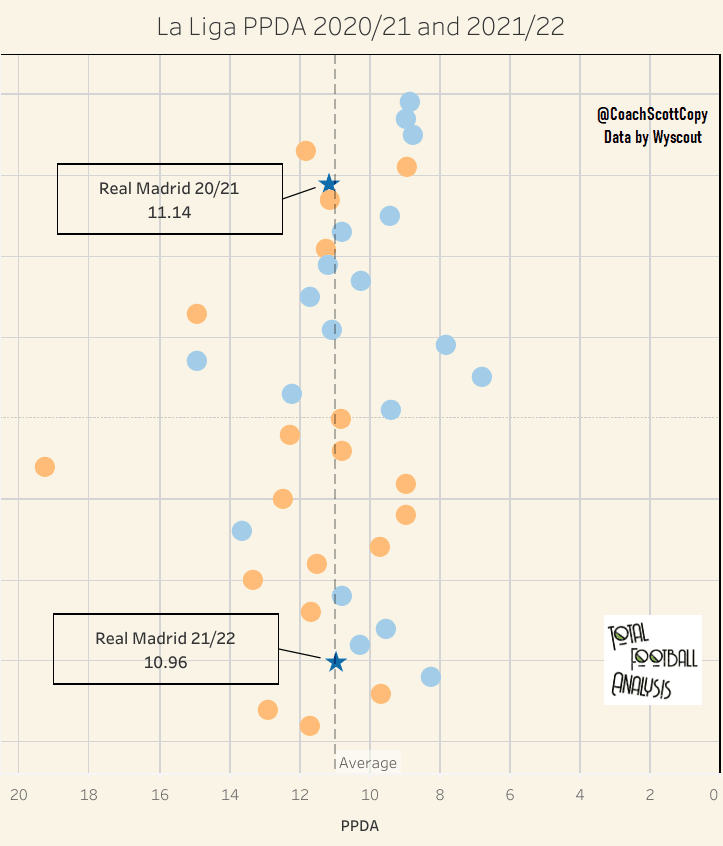
With opponents seemingly approaching their defensive responsibilities in a consistent manner, the next step is to look at whether Madrid is more likely to play out of pressure as they did last year or to bypass it. Surprisingly, Real Madrid has decreased their long balls from 42.42 to 37.88, a 12% drop. Wyscout defines a long pass as one that is longer than 45 m. Kroos has had a minor 5% decrease in long passes per game, whereas Luka Modrić has seen his average drop by 24%.
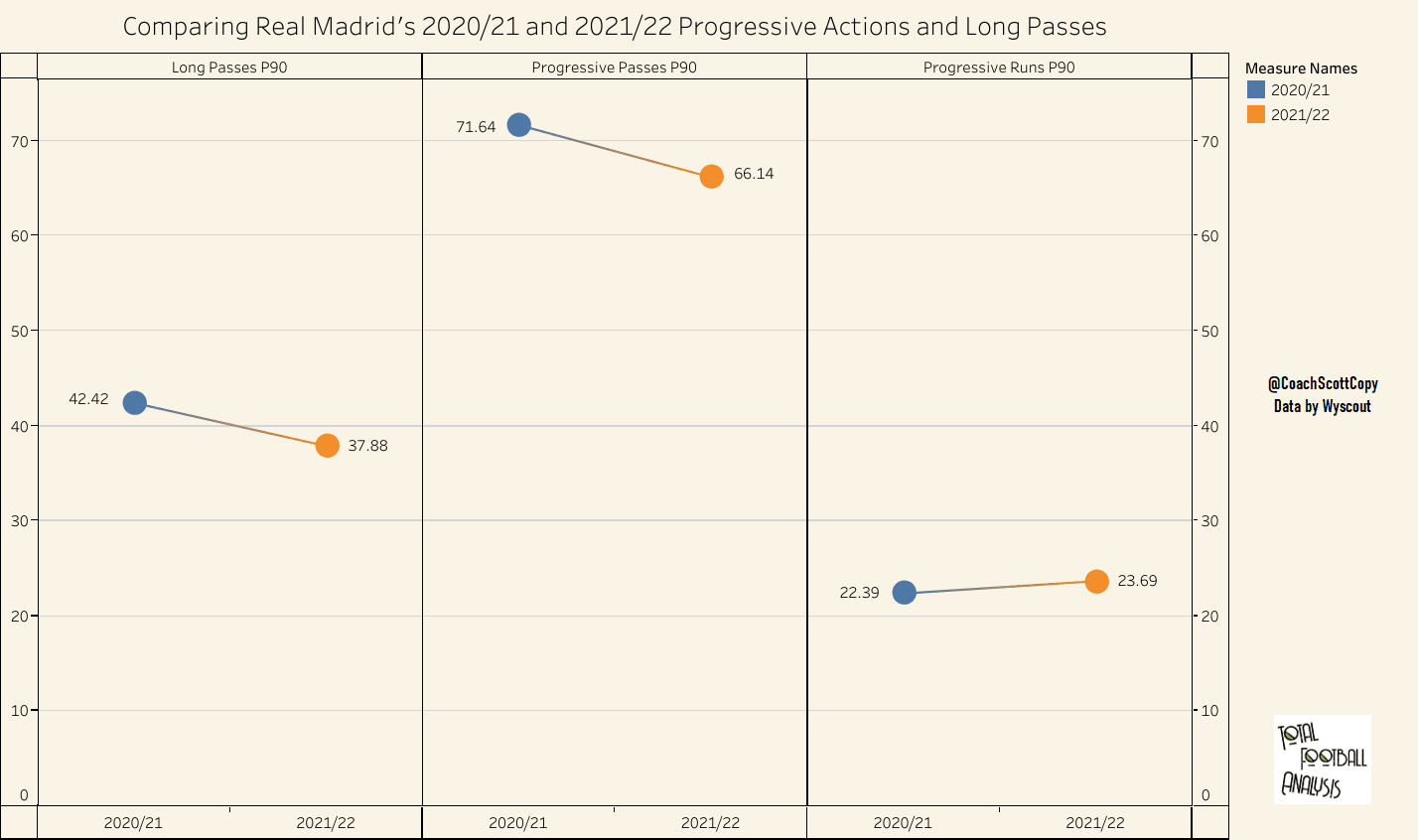
Looking at the progressive action categories, progressive passes have dropped by 8% while progressive runs have increased by 6%. Now, each category has its distance stipulations. The closer to the opponent’s goal, the shorter the distance required for a progressive pass or run (which is more specifically dribbling in open space). The near equivalence in the percentages gives the impression that Real Madrid is attacking the opponent with more space readily available.
That passes the eye test as well.
Returning to the match against Athletic Club, Real Madrid attempted to build out of the back to unbalance their opponent along the y-axis and create space to attack between their lines. However, Athletic Club pressed well while increasing pressure on Thibaut Courtois, who sent a long ball forward.
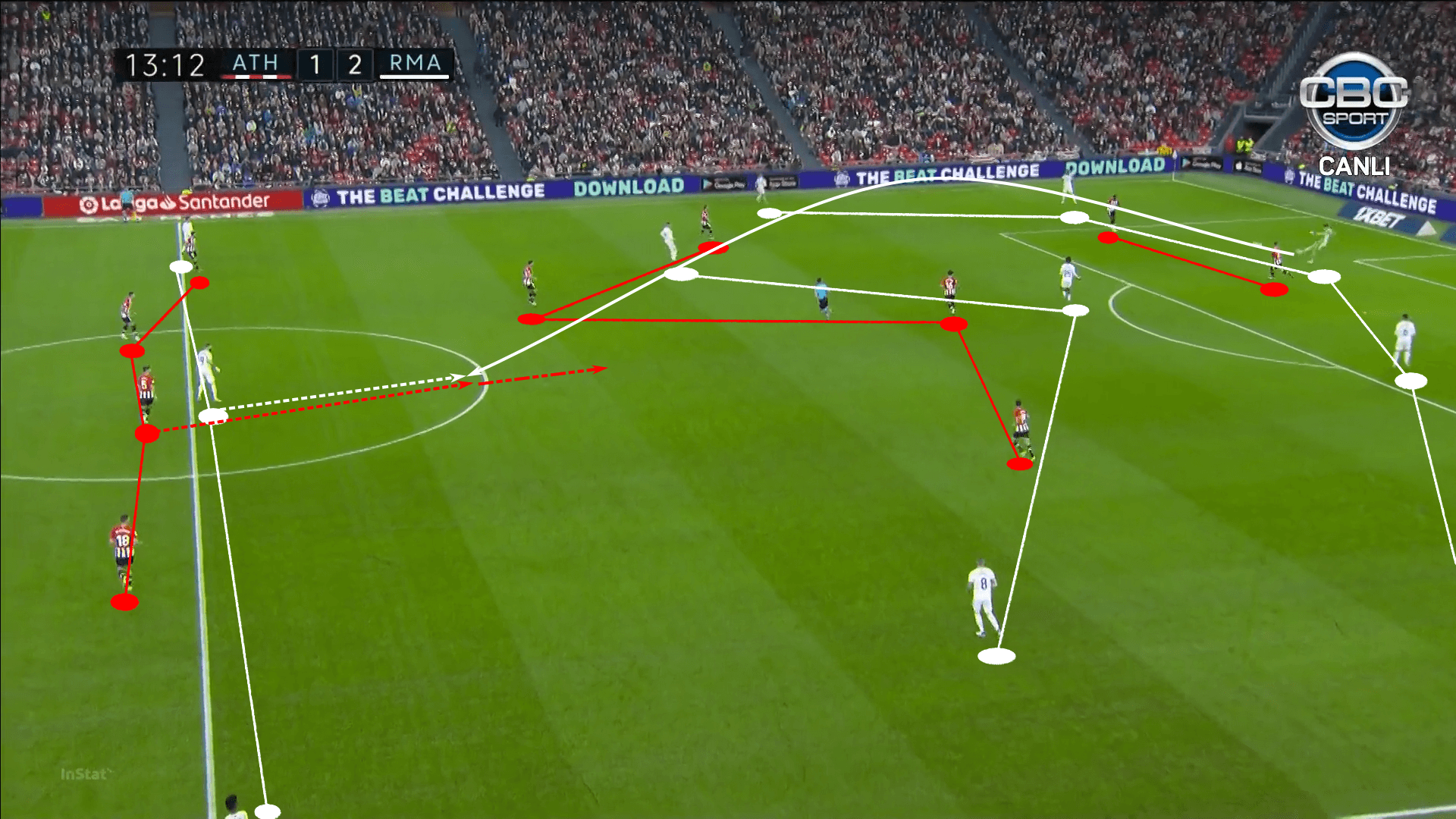
Out of sheer curiosity, I quickly ran the numbers on La Liga goalkeepers’ passes P90 and accurate long ball percentages to gain an idea of how often goalies were used and if Courtois, in particular, was having success picking out his long targets.
The result was surprising.
While he is one of the more heavily used goalkeepers in La Liga, his long pass accuracy percentage is the third-worst in the league.
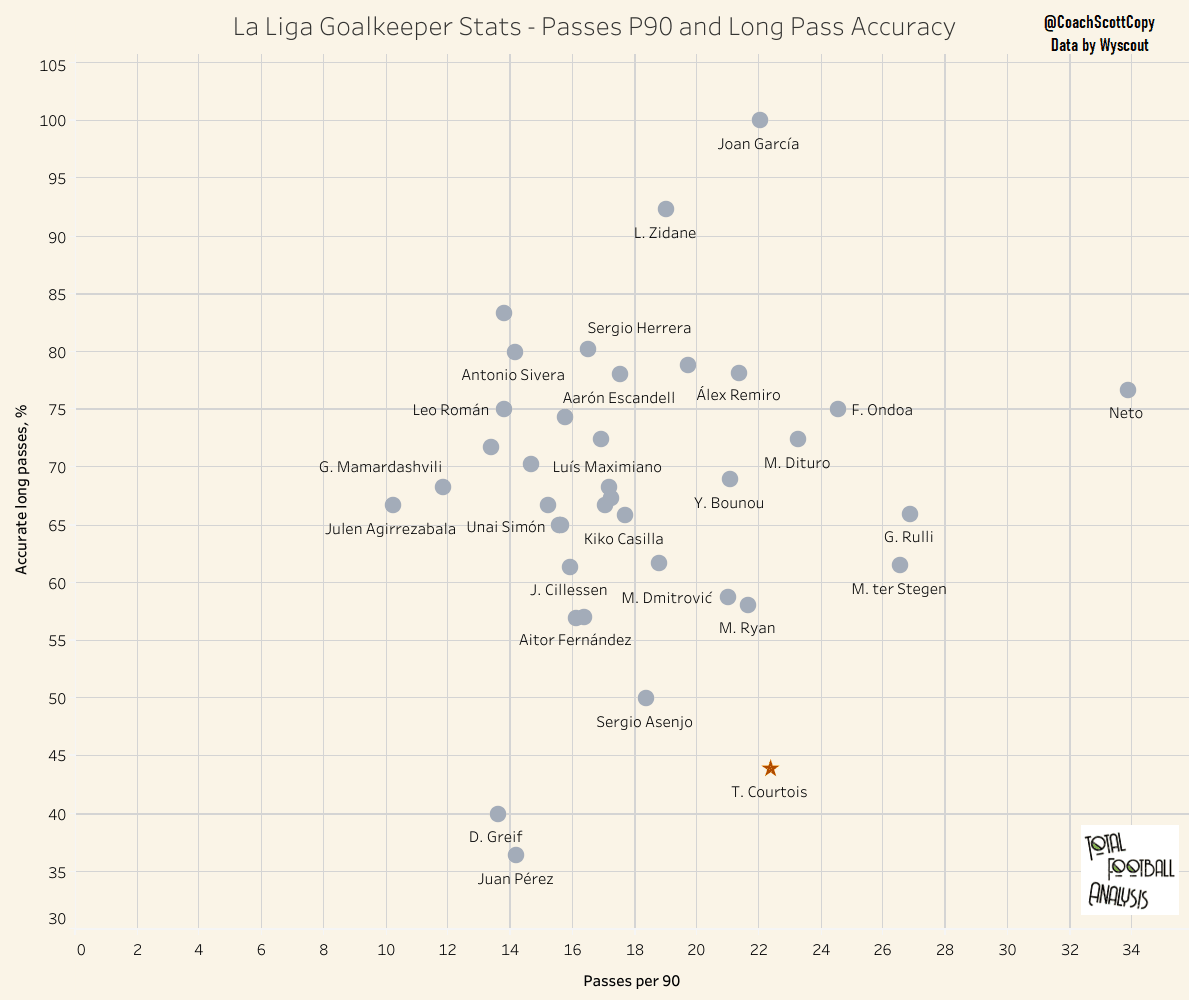
That got me thinking about Domagoj Kostanjšak’s article entitled, “Tactical Theory: Why intentionally losing the ball can be your greatest playmaker.” Then I watched the film and thought about it a little longer because there are times when that certainly seems the case.
Let’s continue with this Athletic Club example. Benzema loses his challenge and Athletic Club enters the final third of the pitch as Real Madrid recover to a more compact defensive shape.
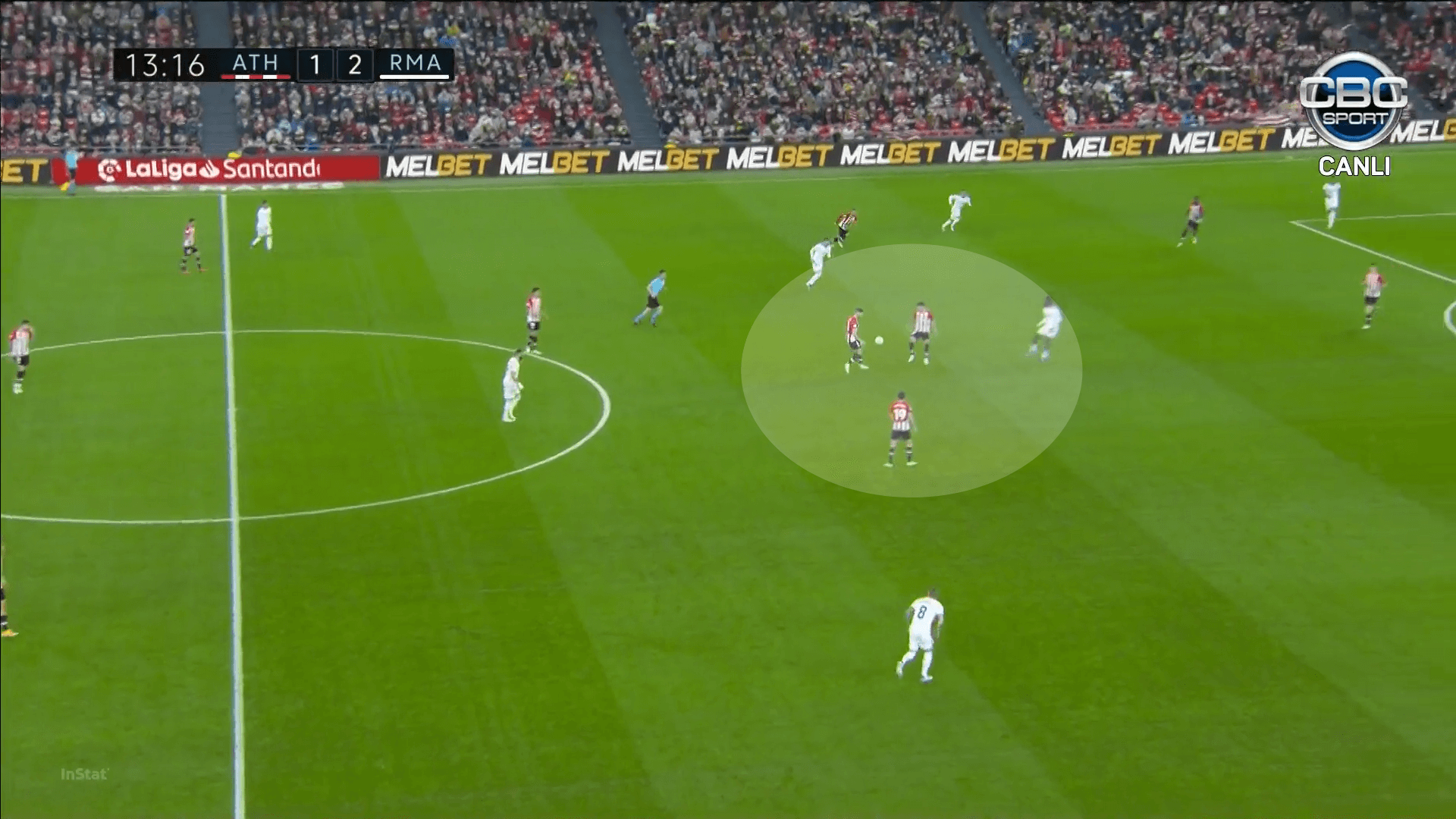
The beauty of their buildup is that their starting positions allow for a quick recovery. By the time Athletic Club nears the box, Real Madrid has a wall of four white shirts at the top of the 18, as well as Camavinga applying backpressure. The young Frenchman managed to knock the ball free, so this is ultimately a view of Real Madrid’s defence the moment Athletic Clubs attack ended. Four players behind the ball with first defender pressure and two recovery runs from midfield against three opponents. Yes, they lost the ball, but they were prepared for the worst-case scenario, minimizing the impact of the loss.
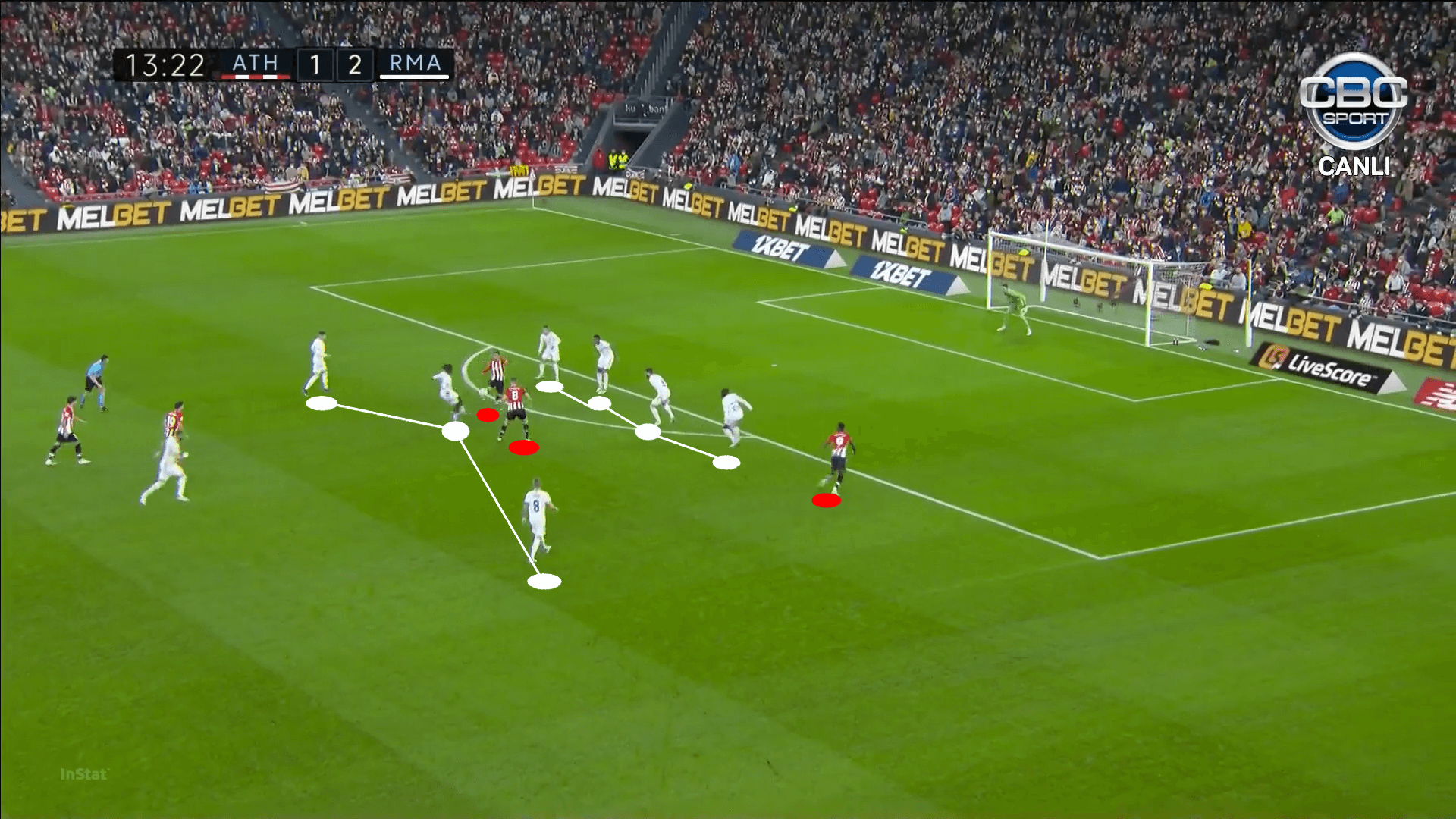
I suppose the worst-case scenario is a goal against. But, with Real Madrid’s rest defence during the build-out, opponents will find goals difficult to come by, making this scenario very close to the worst-case for the La Liga leaders. Now let’s look at the best-case scenario.
Against Atlético Madrid, the crosstown rivals had managed to win the ball and set up in the attacking half of the pitch but Real Madrid applied heavy pressure and made a recovery in the centre of the pitch. Now, six Real Madrid players were ready to engage against six Atlético Madrid players behind the ball. Counterattack on.
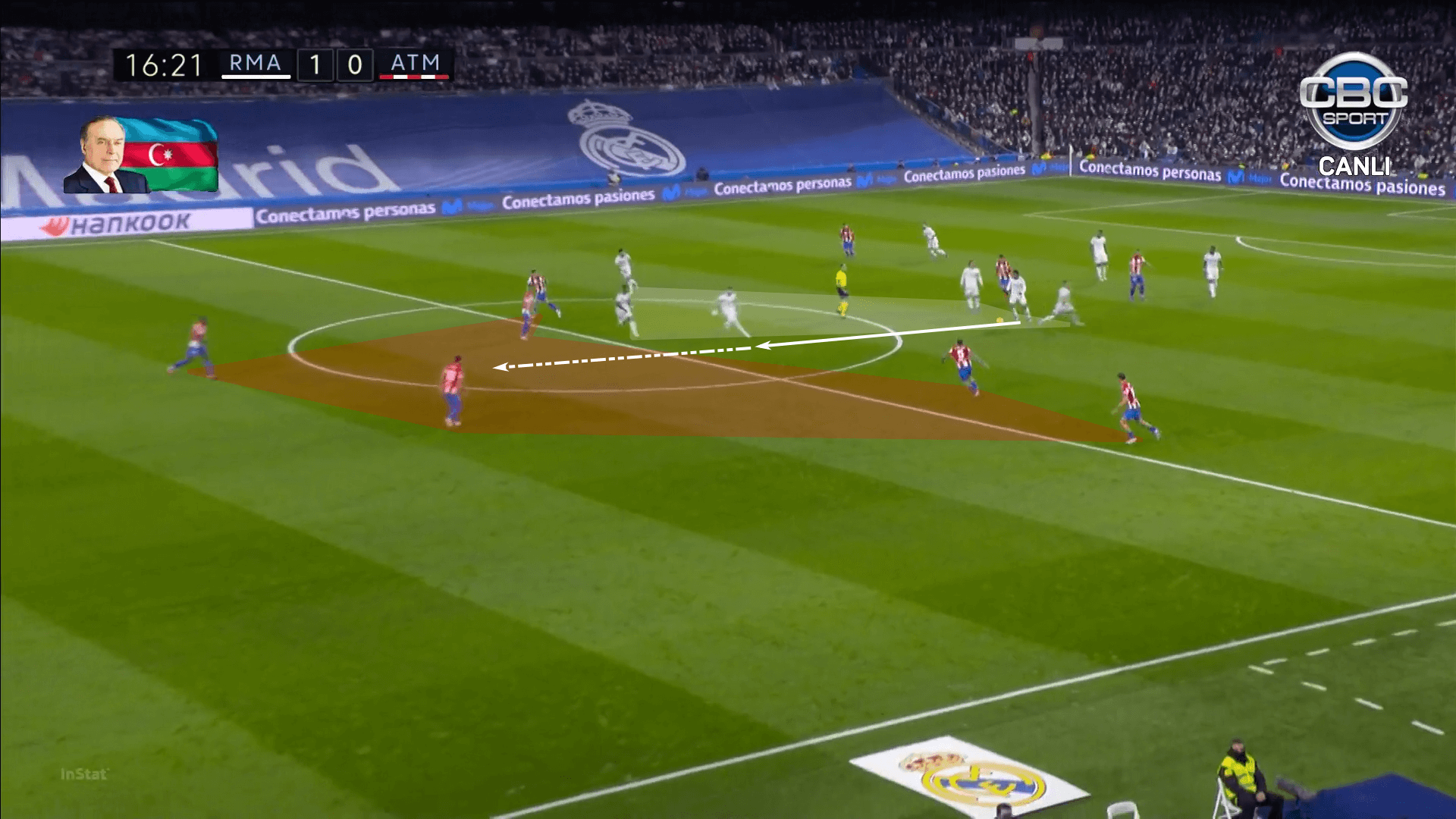
Casemiro’s pass is played into the run of Benzema, who intelligently pins one of the centrebacks before releasing a pass to Asensio. With Geoffrey Kondogbia stepping up to pressure Benzema, a gap emerges between the right centre-back, Felipe, and left-back, Mario Hermoso. Vinícius Júnior used his pace to run into that space, connecting with Asensio. Meanwhile, Benzema continues his run through the centre of the pitch.
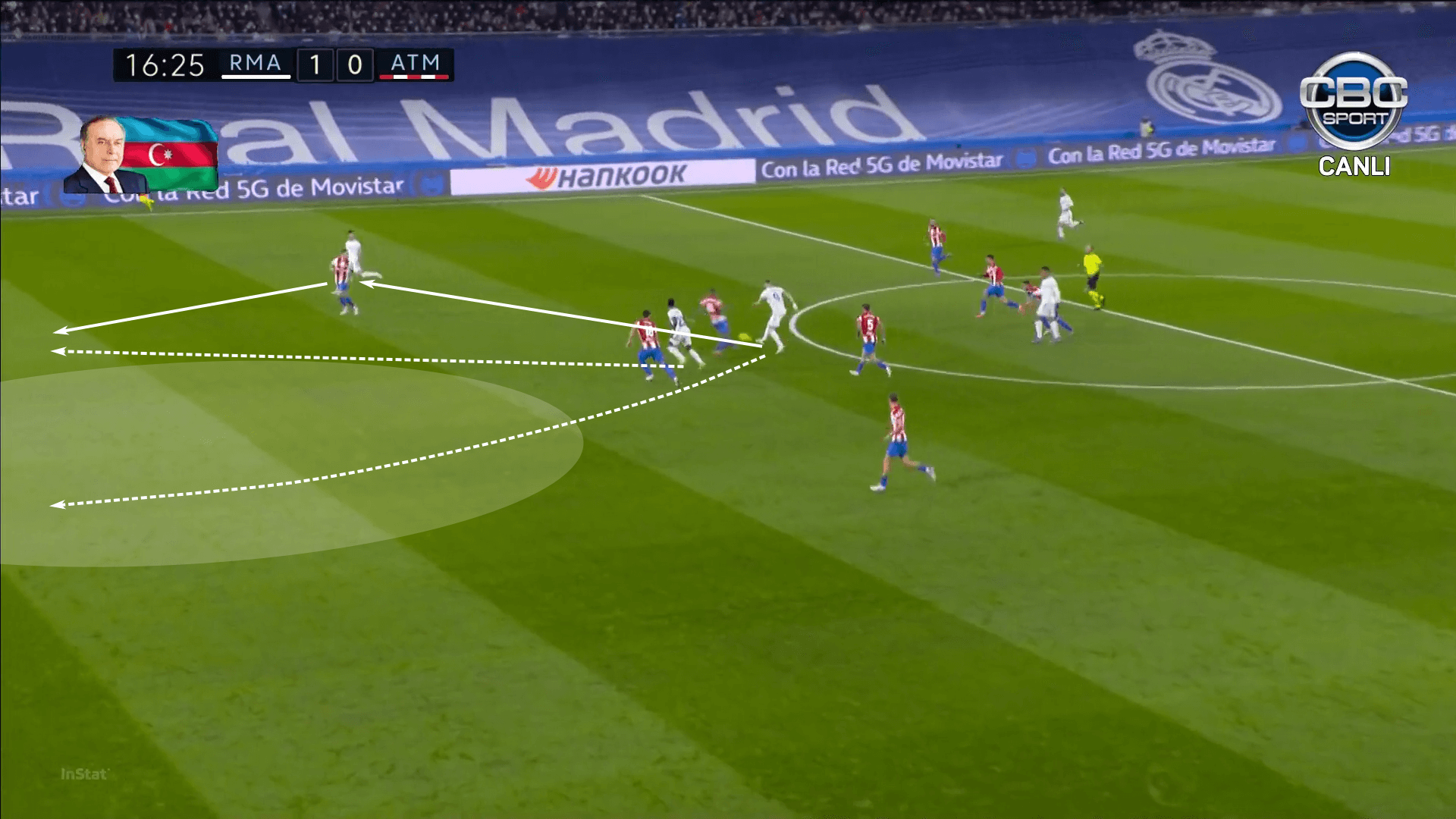
Tempting as it is to show Benzema’s stunning volley, you’ll have to look up the goal yourself.
Instead, we’ll close the section with a few key points about how Ancelotti’s defensive tactics create opportunities for attacking transitions. First, minimise risk out of the back. If under heavy pressure with no outlets, let Courtois play the ball out of pressure and transition to defence. Second, there’s no need to immediately pressure the first attacker. Instead, prioritise defensive shape, taking away the most direct paths to goal and allowing the opposition to advance. Third, when Real Madrid engages, do so from a position of strength. That increases the likelihood of recovering the ball. And finally, stay tightly connected up the pitch to improve the ease of the outlet pass and to create superiorities.
Defend from a position of strength, attack from a position of strength.
Individual improvements
Though this article is all about Carlo Ancelotti’s tactical adjustments and the role they play in producing goals, I’d be remiss to skip this one key factor, which is the individual progressions of key players. The most notable of which is Vinícius Júnior.
In my opinion, he’s Real Madrid’s most important player. When you look at the 20% improvement in goals per game, you don’t have to look any further than the young Brazilian’s drastic improvements in the final third. He’s taken the scoring load off of Benzema, offering the secondary goal scorer that Real Madrid has lacked since Benzema was the Robin to Cristiano Ronaldo’s Batman.
This first Vini Jr. profile comes from last season. His passing and progression numbers are excellent and his defensive actions are decent. However, his attacking and shooting percentiles are rather dreadful, especially when you take away his dribbling and touches in the box. Looking at his heat map, you can see his strong presence on the left-wing, but marginal influence even into the left half-space.
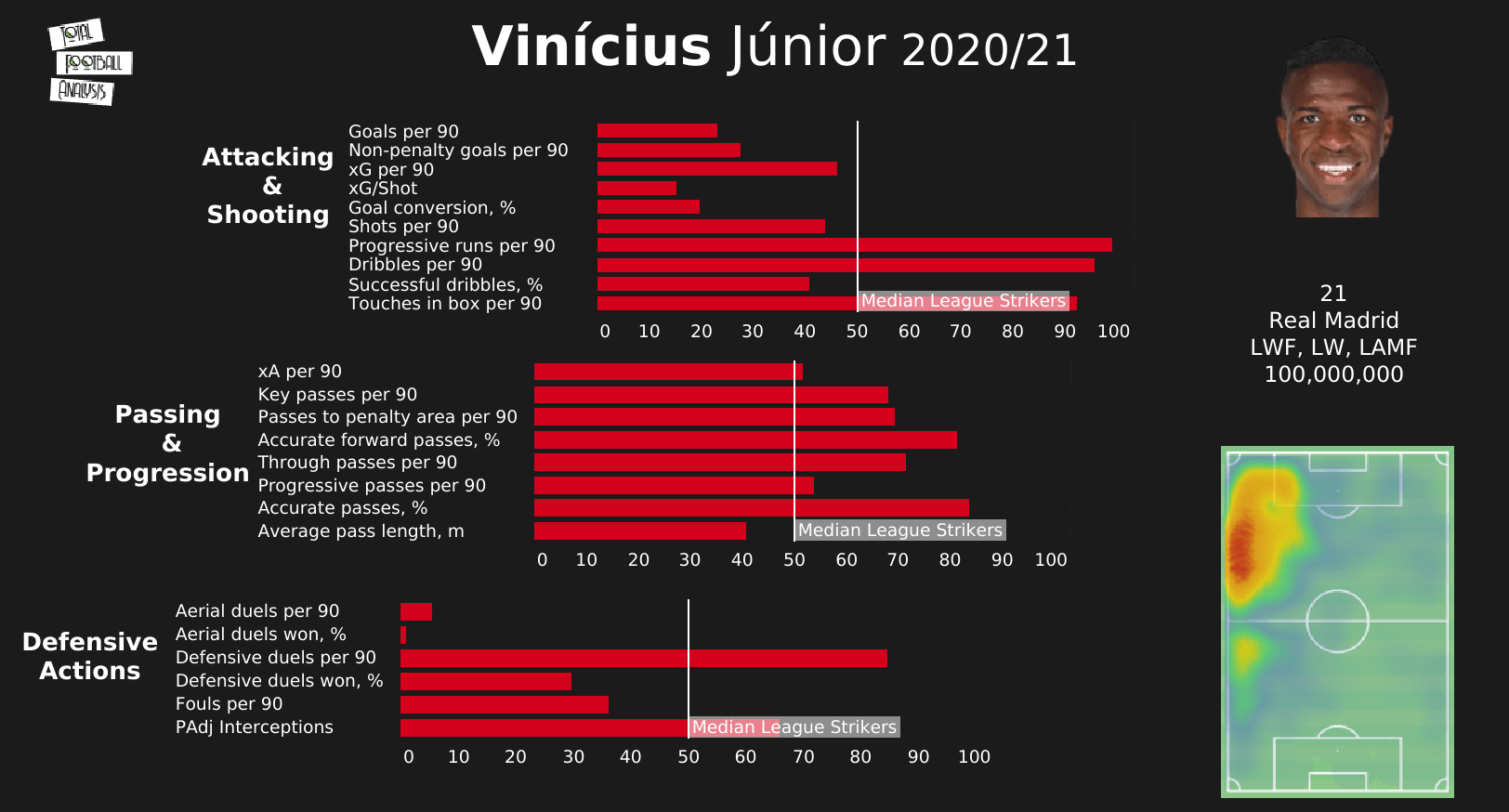
Fast forward to the current season and the profile is almost unrecognisable. He’s still taking low xG shots, but he’s finishing them. His dribbling efficiency has actually gotten worse (though only by 1%), but all of his other attacking and shooting numbers are at or near the top of the league. He has also improved in nearly every passing and progression category, as well as with his defensive production. Ancelotti’s tactics have given Vinícius Júnior the time and space he needs to wreak havoc on opponents. Rather than receiving the ball high in the attacking third, he’s more likely to receive closer to midfield with loads of space to attack behind his opponent. He’s the clear beneficiary of Ancelotti’s game model and the single greatest reason for their improved goalscoring rate.
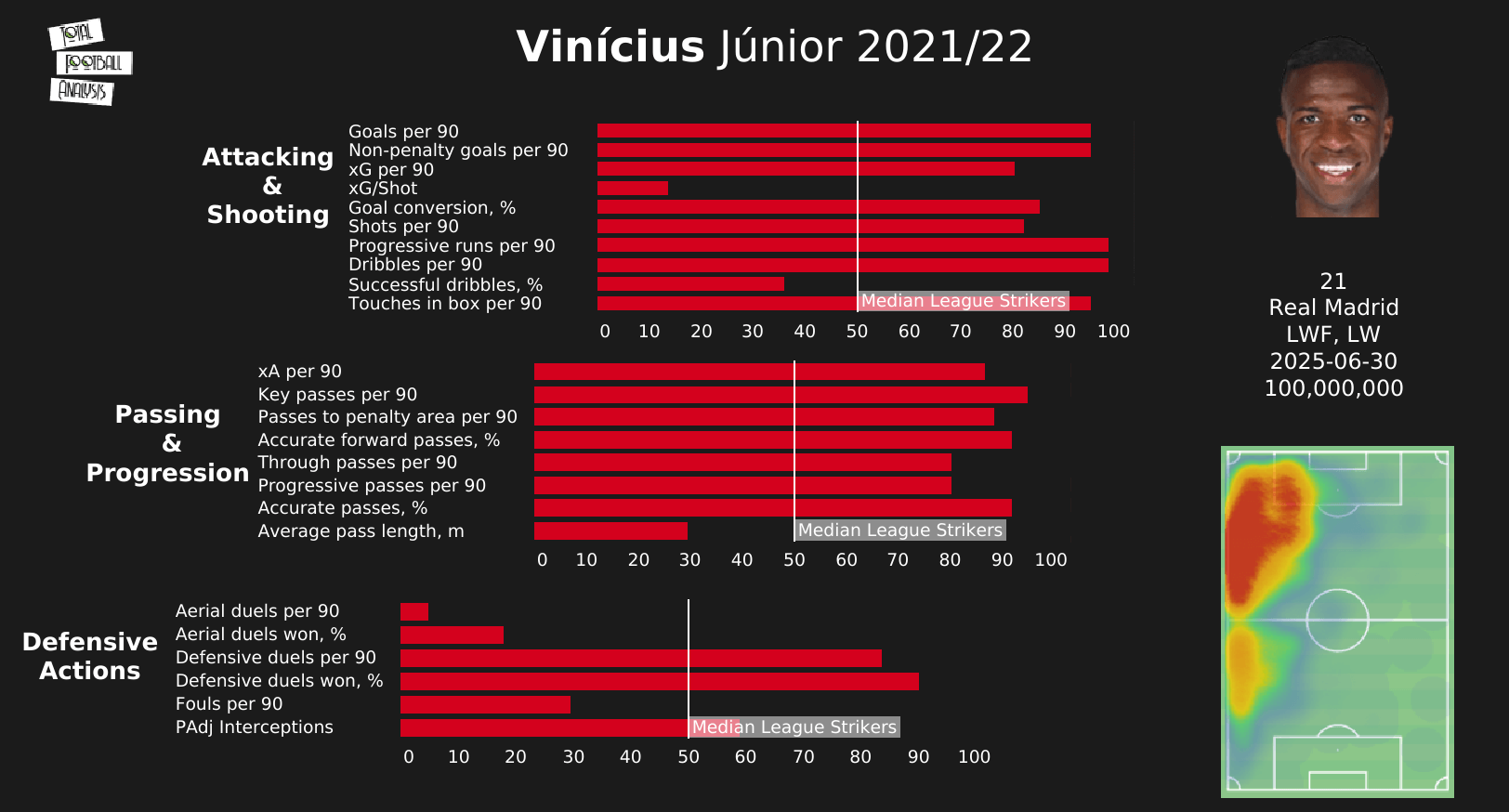
To give an example from a match, even though Vinícius Júnior is about to enter the final third as he receives his pass from Toni Kroos, Real Madrid has done well to create better attacking conditions for the young Brazilian before playing the ball into his feet. The Real Sociedad midfield has lost its presence on the right, leaving a huge amount of space for the right-back to cover. Plus, with Luka Jović occupying both centre-backs, Vini Jr. has the isolation he desires.
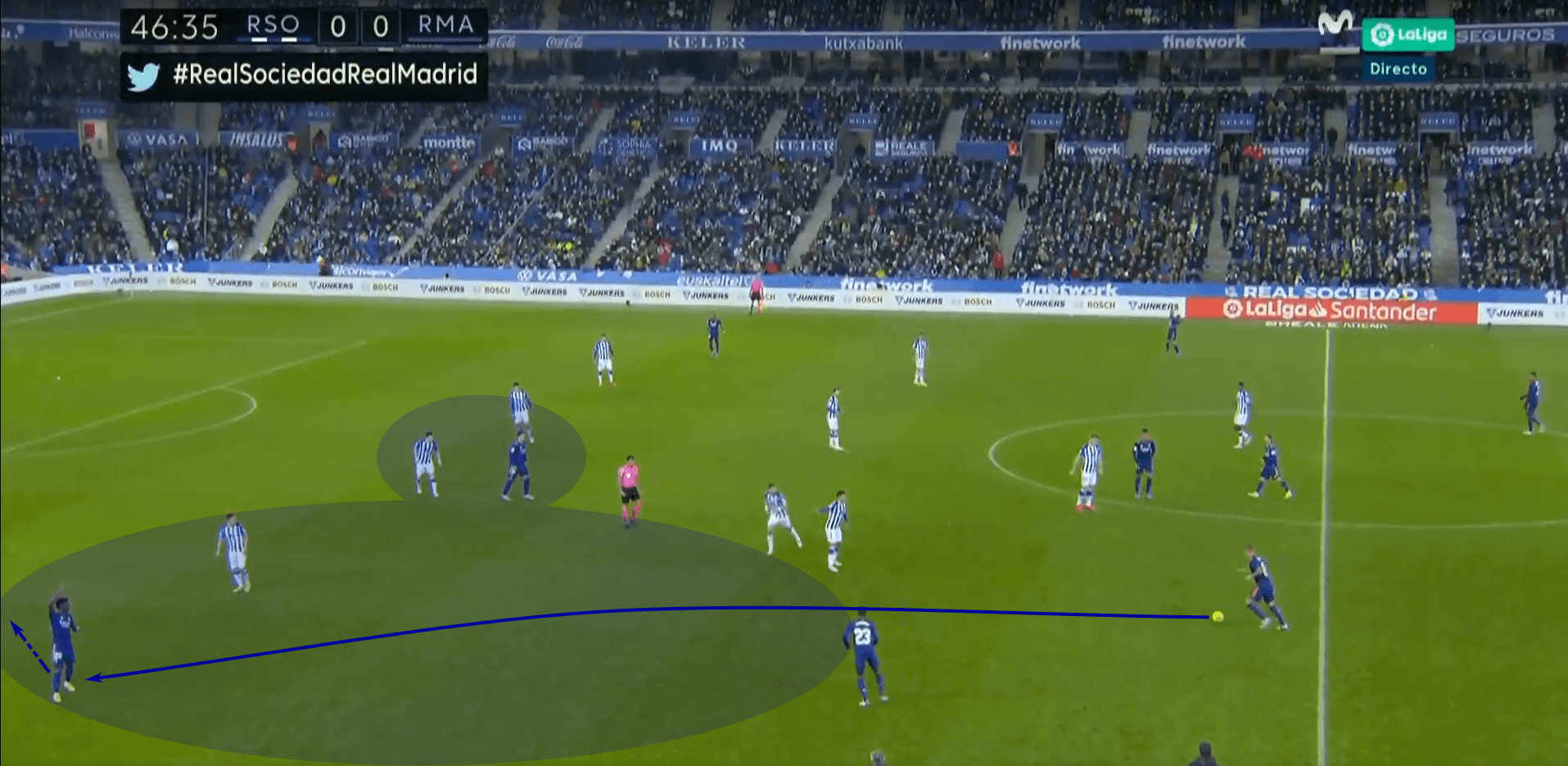
The result is a highlight-reel goal. He beats the right-back, pins the right-centreback and plays a give-and-go around him with Jović before collecting his goal. The shaded area in the second image shows the space he attacked with his run, but that space was hardly closed down before he scored his goal, so it’s a fairly accurate picture of his shooting conditions.
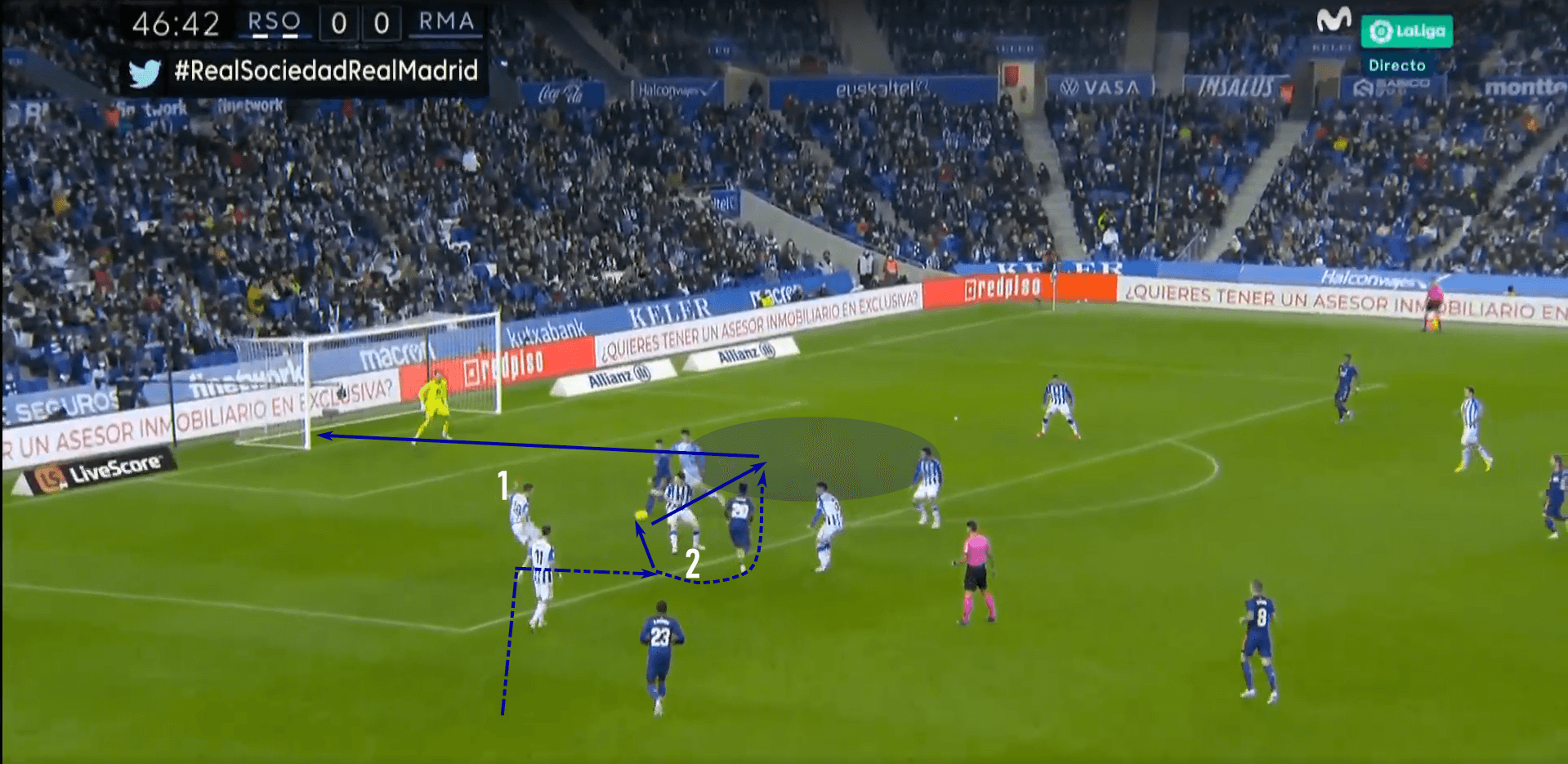
The key, though, is the chaos he created as he made his move into the box. Beating two defenders left Jović 1v1 while Rodrigo occupied the left-back. With his 1v1 win, Vinícius Júnior put Real Sociedad in a position where they were simply running out of bodies to defend with, especially since the midfielders were positioned higher up the pitch, requiring a longer recovery run.
The whole team has benefited from Vinícius Júnior realising his potential, but perhaps no one more than Benzema. The Frenchman has always talked about sacrificing his goal-scoring to facilitate Ronaldo, who was simply more efficient in front of goal. There’s no disputing that fact. But as he has transitioned into the primary goalscorer role, he has had to find the balance between the creative, deep-lying #9 that he enjoys so much and being the primary scorer.
Looking at last season’s profile, he did very well in each area.
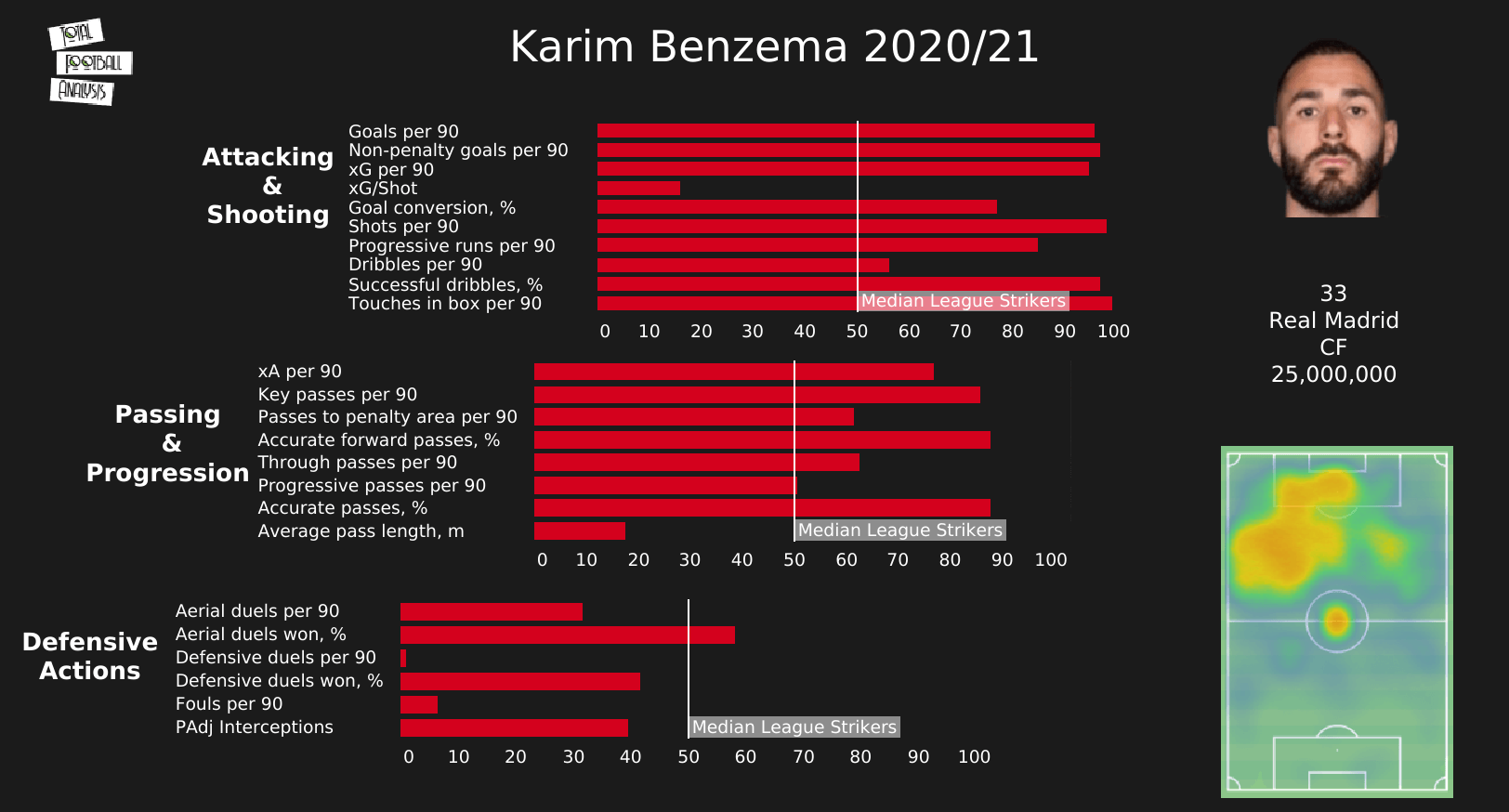
Though it’s difficult to improve upon his 2020/21 numbers, just look at the progression to this season. Interestingly enough, his attacking and shooting numbers have changed very little, but Vinícius Júnior’s growing influence on the game, and Real Madrid’s tactics, have given Benzema even more freedom as a playmaker. His passing and progression numbers are up across the board, nearly all in the 90th percentile or better.
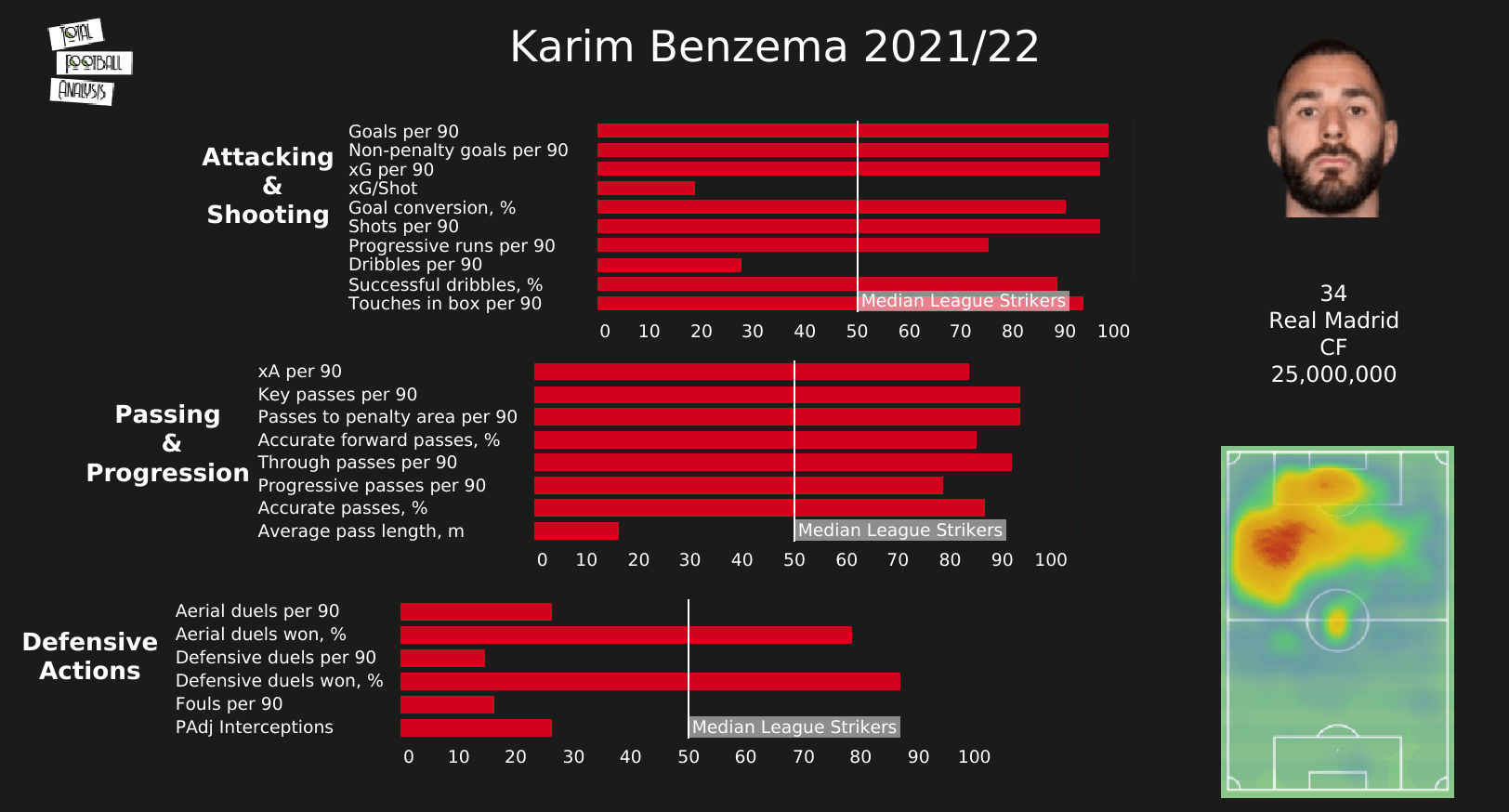
Since Cristiano’s departure, Real Madrid’s attacking burdens have fallen squarely on Benzema. With Vini Jr. ascending to world-class status, that yoke is lighter and we’re seeing the most complete Benzema of his stellar career.
Conclusion
2021/22 was supposed to be the final year of the drought. The final year before the next wave of Galácticos made their way to Madrid to help the club dominate both at home and in Europe once again.
Instead, hope is renewed in the Spanish capital. The attack is flying. Defensive statistics haven’t fallen off much. It’s the most complete this side has looked since Ronaldo’s final year at the club. Some of the youngsters have finally come of age, David Alaba has been a key signing at the back and that midfield refuses to show its age.
Could this be the season for another deep Champions League run? PSG is undoubtedly a difficult Round of 16 matchup, but Carlo Ancelotti and his men have got Madridistas thinking, “we’re back.”

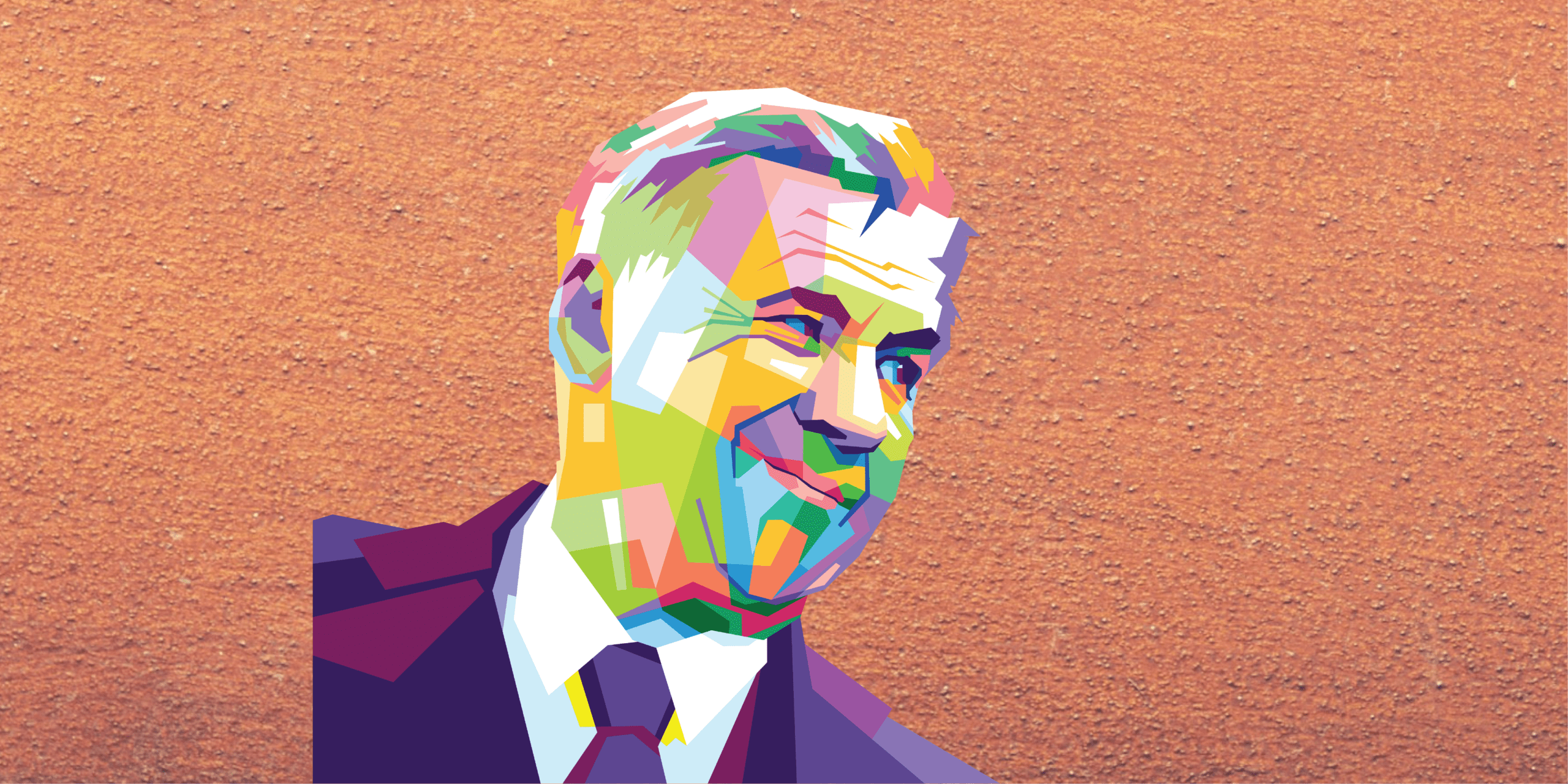



Comments